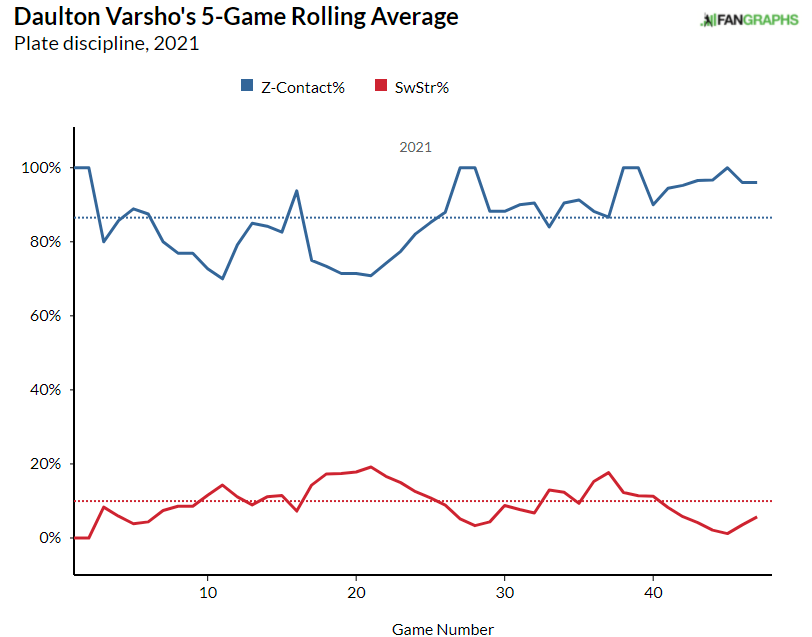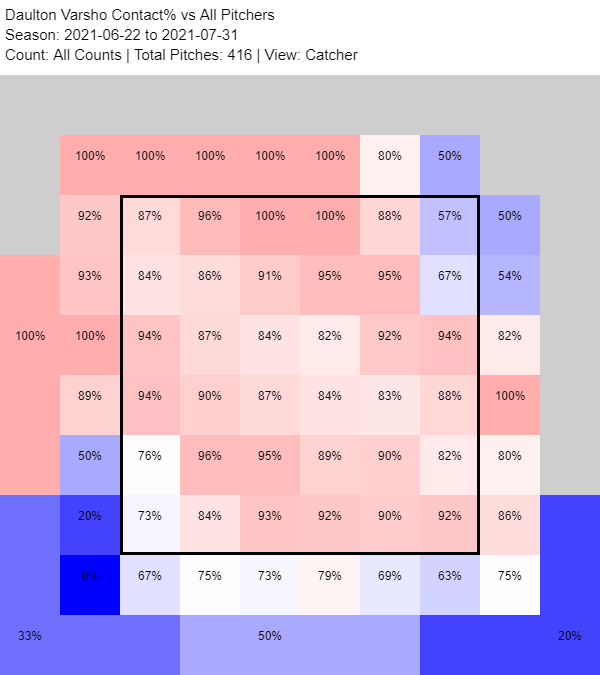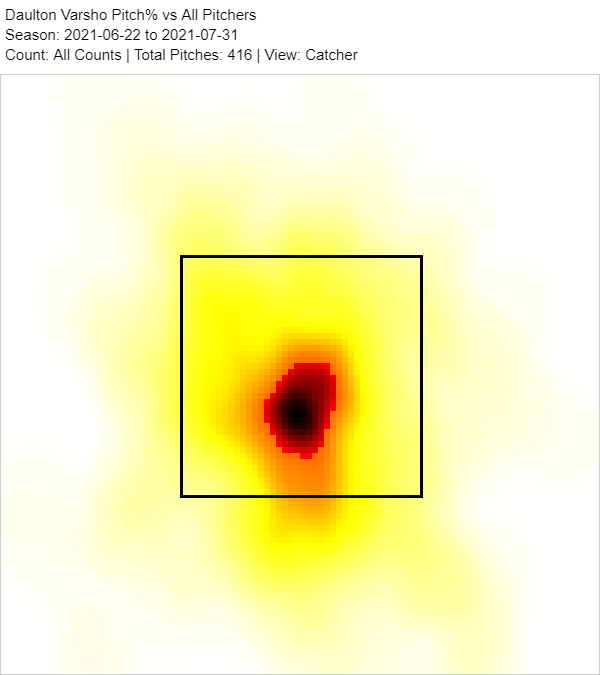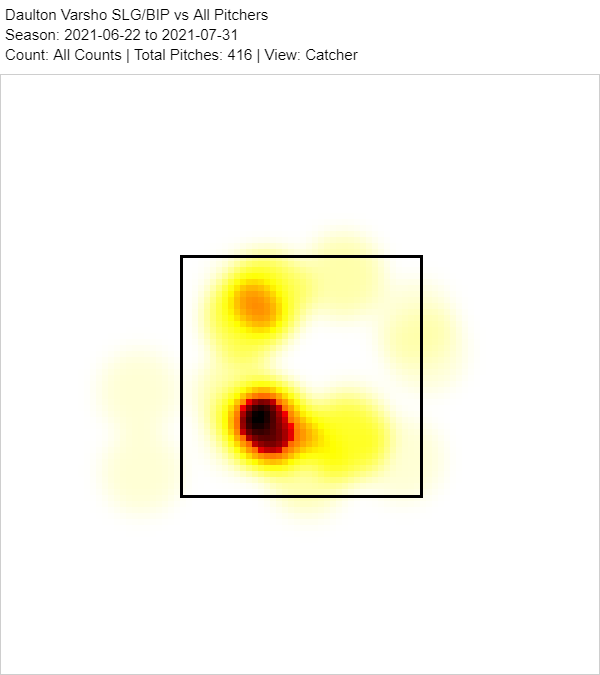Coming into the season, Daulton Varsho was a popular sleeper pick at the catcher position. He was a top-100 prospect coming into 2020, and despite a brief cameo last year that he was probably not fully ready for, his prospect profile definitely shined and stood out as one to watch in the future. The appeal was obvious, especially as a catcher with a solid blend of solid contact skills, average-ish power, and blazing speed. There were definitely many expecting Varsho to be one of the game’s best catchers in the not-so-distant future.
Just to be clear, when we talk about speed, Varsho is a clear outlier among catchers. It’s not just that he has good speed for a catcher, but rather he has some of the best speed in the entire game. Varsho has the best average sprint speed among catchers and all of baseball at 28.7 feet per second of average sprint speed. It ranks in the 89th percentile, and only one other catcher comes close— that being J.T. Realmuto. Even then, Realmuto has only stolen double-digit bases once in his career to this point, whereas scouts envisioned Varsho topping double-digits regularly. Obviously, then, there were legitimate reasons for the Varsho hype train to gain such steam coming into the season.
However, the hype didn’t quite last for most of the spring, as he started the season at the alternate site. Varsho was eventually called up to the Arizona Diamondbacks in late April, where he stuck around for about a month, in which he didn’t play very well at all, as he slashed just .171/.227/.244 (28 wRC+). Varsho only accumulated 44 plate appearances in that span, but it was tough to watch. He looked overmatched, and no amount of speed alone would be enough to justify keeping him at the Major League level. He was rightfully sent back down, and with that, the hype for Varsho probably reached an all-time low.
As for what went wrong for Varsho in that span, it seemed to be a combination of a few different things. After all, it’s hard to put up the slash line that he did by pure coincidence. First off, it seemed like Varsho had trouble making contact early on in the season, which was supposed to be one of his strengths. His swinging-strike rate was an elevated 12.6% during his first call-up, which was higher than it was during his minor league career and higher than it was when he was down in AAA after being sent down:
Additionally, perhaps a worrying sign was that, while his early-season rate was lower than 2020’s, it still was a continuation of an elevated swinging-strike rate from 2020. For context, the Major League average swinging-strike rate is around 11%, so Varsho was swinging and missing at a rate slightly greater than league average. That likely partially explains, at least, why his strikeout rate was an elevated 27.3% as well to open the year. Varsho never had much of a strikeout issue at all during his time in the minor leagues, but swinging and missing more will certainly cause it to rise.
That alone isn’t enough to cause the struggles he went through, though. The bigger factor was that he was making a lot of weaker contact. Looking at the soft contact rates of all hitters in the first two months of the season, we see that Varsho had one of the top-five highest rates:
That definitely isn’t ideal. For Varsho, he wasn’t able to make up for it with a ton of hard contact either, as his rate of hard contact in the same span was an identical 31%. The downsides of such a high amount of soft contact are obvious, in that it is tough to turn soft contact into hits on a consistent basis, but in the case of Varsho, soft contact is even more of a killer considering his batted-ball distribution. Consider Varsho’s rates on each of the three batted-ball types during his poor stretch compared to the league average rates:
We see that Varsho was actually doing what we would want to see a hitter do here—keep the ball off the ground. Over 70% of the contact he made ended up in the air, including a whopping 51% of them being fly balls—both rates being among the highest in the game in that span. That would normally be a good thing, but when a hitter is making such a great amount of soft contact, it’s tougher to turn those better batted balls into hits, especially fly balls, since weak fly balls generally don’t accomplish much and tend to be easier outs. This was especially the case for Varsho, as his soft contact issues were even more pertinent when zooming in and focusing only on his fly balls:
It’s no surprise then that with such a high total of fly balls hit, with the majority of them being weakly hit, that Varsho struggled so much to begin the season. Additionally, his average fly ball distance per Statcast was just 309 feet, which clocks in below-average. It’s definitely not the place where a primarily fly ball hitter would want to be, and it shouldn’t be much of a surprise then that, all told, Varsho managed just one hit on his fly balls at the beginning of the season.
To make matters even worse, of all of those fly balls he hit, a high 20% of them were infield fly balls. It’s hard enough to turn weak fly balls into hits, and now adding in near-automatic infield fly ball out outs into the equation, and it was going to be nearly impossible for Varsho to have much success at the plate with both things bleeding into his profile. His early-season results look pretty justified when broken down this way, and there was definitely no blame thrown the D-Backs’ way when they decided to send him down to Triple-A Reno at the end of May.
Varsho did make a return to the Majors in late June, though. With the D-Backs struggling mightily and Varsho tearing up AAA to the tune of a .313/.368/.775 slash line, which even in the extremely hitter-friendly Triple-A West, still adjusted to a killer 157 wRC+, the team decided to give him another look. In the time since, Varsho has been a much different hitter. He has a .232/.364/.451 slash line, good for a119 wRC+ in that span.
He’s been even better within the month of July specifically, as he was one of the game’s better hitters for the month with a .279/.397/.574 slash line for a 155 wRC+. He’s hitting for average and power, and he notably went on a home run binge, with a three-game home run streak from July 21st through the 24th, and suddenly, in a complete 180 from the narrative earlier in the year, the hype surrounding Varsho is starting to return, and for good reason.
As for what is driving Varsho’s improvement lately, let’s go back and look at swinging strikes and his rate of contact—recalling that those were two areas in which he struggled during his first stints in the Majors. Since being called back up, Varsho’s swinging-strike rate has improved considerably, and even more so within the last few weeks, to 8.7%, a rate which is nearly identical to the 8.6% swinging-strike rate he put up at Triple-A this year. Corresponding with that drop in swinging strikes, Varsho’s rate of in-zone contact has spiked substantially since his second call-up:

Here we see the jump in Varsho’s zone-contact and subsequent decline in swinging-strikes started right around game 20 on the chart, which matches up with right when he got called back up to Arizona. So, it seems like those improvements were made pretty much right away, and there hasn’t really been much change in the weeks since. It’s been a pretty clear and lasting improvement.
Due to those improvements in contact, his strikeout rate has also dropped from the upper-20% range it was earlier in the season. All in all, in terms of just the raw numbers, it’s clear that Varsho has been much better in this area of his game lately than he was earlier in the year:
The improvement in terms of zone contact may be what is most impressive here, as Varsho was quite poor in that area earlier in the year but has been one of the league’s best in the time since, and since the start of July, his zone-contact rate of 92.9% is one of the top-30 highest in the game. Looking at where in the zone that extra contact is being made, it’s pretty clear that the difference has been made on pitches at the top of the zone:


We see that while Varsho has been better in pretty much every area of the zone, the differences at the top are definitely the biggest. It is still good to see him better all-around the zone, too, especially considering that the quality of the contact he’s making has been much better. Remember how much soft contact Varsho was making earlier in the year? Well, that’s changed for the better lately, as soft contact has become much rarer for him lately:
That is definitely quite the turnaround. Also, this shift in contact quality has translated to his fly balls, which were also hit extremely poorly earlier in the year:
While he has been hitting more groundballs during this better stretch at 41.9%, but he’s still running a strong flyball rate at 42.9%. Those extra grounders haven’t caused him much trouble overall, in part, because he’s been hitting the better batted-ball types much better. To go along with that, his average fly ball distance in this span has improved to 321 feet, and he’s cut his rate of infield fly balls at a great rate to just 8.3%, down from the 20% clip he posted previously, while his home run per fly ball rate has spiked to a whopping 20.8%, with all five of his home runs for the season coming post-June.
There’s little doubt that Varsho looks a lot better at the plate, both in terms of making contact and making higher-quality contact. It’s good and important to see that this level of performance is backed up by advancements in the numbers, rather than just something that looks flukish, but there is still something about Varsho during this run of good performance that needs to be mentioned. It has less to do with Varsho himself but rather the pitchers throwing the balls to him—namely, where they’re throwing them in the zone. Take a look at the pitch heatmap for Varsho since June:

That sure does look like a lot of pitches in the dead-center of the plate. now, there are probably a few reasons for this. The first likely has to do with the fact that Varsho had been pretty bad at the plate at the Major League level during his previous two stints, so pitchers perhaps felt like they didn’t have to challenge him as much and, with all of the weak contact he made, perhaps they felt as if they could get away with some mistakes in the middle of the plate. Another reason could be due to where Varsho hits in the D-Backs’ batting order. He has primarily been hitting either seventh or eighth for the team for the vast majority of the year, and pitchers will generally pitch differently to hitters in the bottom third of the order compared to those at the top. The thing is, though, that Varsho has absolutely made pitchers pay for those mistake pitches left in the heart of the plate, shown by the damage done in terms of the overall slash line, but also when looking at where in the zone his best results have come. Spoiler alert, it matches up pretty well to the same area as where he’s been pitched:

Just based on this—that Varsho is punishing mistakes—it seems likely that opposing pitchers will make some sort of adjustment to how they approach pitching to Varsho going forward. That may require another adjustment from Varsho, and whether he makes it or not may determine just how much of this hot streak is real and representative of the type of player he’ll be going forward or not.
Adjustments are a big part of baseball, after all, and it seems like it’s something we’ll just have to wait and see on for right now. But, it is still nice to see improvement and a strong run of success for Varsho at the plate, which has seen him recuperate some of the hype that was lost after a poor start to the season. He has improved big time on what were his two biggest weaknesses earlier in the year—not making enough contact, and the contact he was making, being extremely weak.
It’s good to see a former top-prospect start to have success at the Majors. He’s on a hot run right now, which he’ll definitely come down from, but it does seem like Varsho is beginning to find his footing at the Major League level and start to get more comfortable.
Photo by Peter Joneleit/Icon Sportswire | Adapted by Doug Carlin (@Bdougals on Twitter)


Plus he plays duel positions in yahoo……C & OF